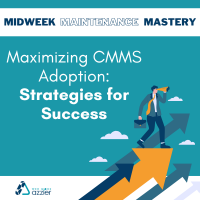Achieving the highest level of user adoption of a Computerized Maintenance Management System (CMMS) requires more than just implementing the right technology. It involves careful planning, clear communication, and a strategic focus on people and processes. For organizations looking to transform their maintenance operations through CMMS, fostering enthusiastic adoption across the workforce is essential to realizing the full value of the system. This begins with addressing human factors as much as technical considerations.
Overcoming Resistance to Change
Resistance is a natural response to change, particularly when it disrupts long-standing workflows or introduces unfamiliar tools. Employees may worry about increased oversight, job complexity, or even job security. To counter this, leadership must clearly communicate the reasons behind the CMMS implementation. Explain the benefits not just for the organization but for the individuals using it — reduced paperwork, more efficient processes, fewer emergency repairs, and improved visibility into work history and task prioritization. If they understand how it directly benefits them—whether through fewer equipment failures or simplified processes—they’ll be more inclined to use it.
Engaging users early in the selection and implementation process is another powerful way to overcome resistance. When frontline staff feel their input is valued, they are more likely to support and champion the transition. Encourage feedback, answer concerns with transparency, and provide real examples of how the system will solve their everyday problems.
Instilling Confidence Through Training
No matter how intuitive a CMMS may be, user training is critical. Effective training goes beyond software functionality. It should demonstrate how the CMMS integrates with daily operations, how users benefit from it, and how it simplifies — rather than complicates — their work. Tailor sessions for different user roles (technicians, supervisors, administrators) and incorporate hands-on activities that reflect real-world tasks. Your staff doesn’t need to learn every feature of the CMMS, just those that matter to their specific roles. With Azzier’s customizable training options, maintenance techs can focus on creating work orders through mobile apps, while managers can leverage advanced reporting and KPIs to streamline operations. Tailored training means employees can immediately see the impact on their daily tasks, building confidence without feeling overwhelmed.
As the system evolves or staff turnover occurs, continuous learning ensures knowledge gaps don’t become obstacles to full adoption. Offer refresher sessions, maintain an accessible knowledge base, and assign system “champions” within departments to offer peer-to-peer guidance.
Leadership by Example
Adoption efforts are far more effective when leadership is visibly supportive and engaged. Managers and supervisors must use the CMMS themselves and consistently refer to it in decision-making processes. When employees see that leadership relies on the system, they are more likely to follow suit.
Leaders should also recognize and reward staff members who effectively adopt and leverage the CMMS. Acknowledging successes — whether it’s improved asset uptime, reduced response times, or better reporting — reinforces the value of the system and motivates others to engage. This reinforces that the CMMS isn’t just a tool for maintenance teams—it’s a strategic asset for the entire organization. Rewarding data-driven improvements shows your team that their efforts are aligned with the company’s broader goals.
Establishing Clear Expectations and Accountability
Successful CMMS adoption is built on structure. Set clear expectations for how and when the system should be used — for example, entering work orders, logging completed tasks, or conducting inspections. These standards should be integrated into job descriptions and performance evaluations to establish accountability. However, accountability should be framed positively. Rather than using the CMMS to police activity, use it as a tool to support individual and team success. When staff see that it helps them achieve goals and demonstrates their productivity, their perception of the system becomes more favorable.
Continuous Improvement and Iterative Optimization
Adoption doesn’t end at go-live. Even with a strong rollout, the first version of any CMMS configuration may require refinements. Collect feedback from users regularly to identify areas where workflows can be adjusted, features can be better utilized, or user interfaces can be simplified.
This iterative approach encourages users to be active participants in shaping the system. It reinforces the idea that the CMMS is not a rigid mandate, but a living tool that adapts to evolving needs. Continuous improvement also signals that the organization is committed to long-term success, not just a one-time software implementation.
Aligning the CMMS with Real-World Goals
The most effective way to drive CMMS adoption is to make its value tangible. Use the system to generate reports that help users and leadership alike see results: reduced downtime, faster response times, improved compliance, or better inventory control. These wins should be communicated regularly to all stakeholders.
Additionally, integrate the CMMS into broader operational strategies — such as sustainability initiatives, capital planning, or safety compliance — so it’s viewed as an indispensable component of the organization’s success rather than just a maintenance tool.
Cultivating a Culture of Ownership and Empowerment
Finally, adoption thrives in a culture that encourages ownership. When users feel empowered to use the CMMS proactively — suggesting improvements, customizing dashboards, analyzing reports — they take greater pride in its success. Provide tools and time for users to explore system features that go beyond their minimum requirements. Empowerment leads to deeper engagement and long-term system sustainability.
Achieving high user adoption is not about mandating change — it’s about building confidence, clarity, and shared ownership around a tool that supports everyone’s success. A thoughtfully implemented CMMS, paired with a people-centered adoption strategy, becomes far more than software. It becomes a catalyst for better performance, transparency, and collaboration throughout the organization.




